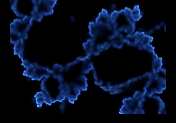
Fractal Architect 4 Help Index
Applies to:FAFA 3DFA 3D-AV
Each flame fractal has a palette of 256 colors (most commonly) that are applied to the fractal shapes. This palette is frequently called the color gradient. A color index is calculated for each point based largely on the last transform to add to that point’s histogram. This algorithm is great at revealing the geometric beauty of the geometric variations making up the transform.
Unfortunately it makes direct, precise control of fractal colorization impossible. Typically a fractal designer uses a trial and error approach trying various color gradients until one stands out.
Reference: Gradient Editor
Fractal Architect makes it easy to quickly change various color gradient values and see the changes in the fractal image resulting from those changes. The current fractal state is shown by a floating thumbnail image.
To keep image rendering fast, its important to keep the thumbnail window small. It can be resized by dragging the bottom-right corner of the image. Thumbnail rendering time is shown on the Fractal Architect log window. Its good to keep the rendering time down to about 1/2 second or so.
Click on the thumbnail image window and press the spacebar. You should see the Quicklook window pop up. Press the spacebar again to close it. Quicklook is available throughout the application.
The color gradient editor does not provide undo support for color experimentation. Instead, you can add the current color gradient to the UGR list by clicking the + button on the UGR List tab.
You can switch back and forth between color gradients on the UGR List, by selecting a particular gradient on the UGR list and pressing the Use button.
Because you may need to make lots of trial and error attempts, the color gradient editor works on a copy of the fractal. You need to explicitly transfer the color gradient to the fractal definition to make it permanent.
Press the Apply to Fractal Preview to make the current color gradient part of the fractal documents definition.
This tutorial will show how you can modify the fractal colors using the current color gradient as a starting point.

Go to the Welcome Screen window. (One way is to use the menu: Window > Welcome to Fractal Architect. Or use the Command- ~ (Command+tilde) key combination to quickly cycle through the application’s windows.)
Click on the Gallery tab. Double click on the thumbnail image to open its Preview window. Right click with the mouse to open the preview window’s context menu and select: Open Color Gradient Editor….
Find the slider in the box labeled: Modify Gradient By:. The pop-up menu button should show the label: Rotate. If not, open the menu by clicking the button and select that menu item.
Grab the slider and drag it around. Watch the fractal image till you find a color combination you like.
This fractal is stubbornly monochromatic. To inject some more colors we need to increase the frequency of color changes in the gradient. Click the menu button and select the item: Frequency. Drag the slider all the way to the right.
Now set the button back to Rotate. Now drag the slider around and you should see some other colors.
This tutorial shows you how to create a brand new color gradient using optional Color Harmony schemes.
For this fractal, using a large number of color stops works well. Select the Random tab in the Overwrite Gradient With: box. Set the number of color stops to 64. Click the Create New button repeatedly until you find a fractal colorization you like.
Pick a color scheme using the pop-up menu button. See Gradient Editor for an explanation of what the different schemes mean.
Pick a starting color by clicking and changing the color well button.
You can adjust the color weights to influence the color selection and add extra random colors too by adjusting its weight slider.